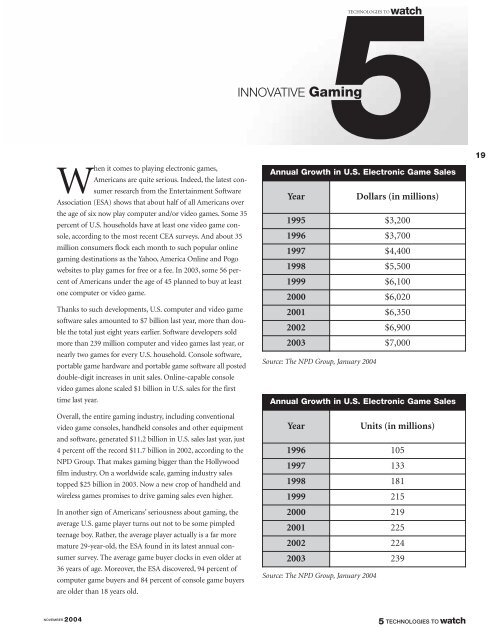TECHNOLOGIES TO watch - Consumer Electronics Association
TECHNOLOGIES TO watch - Consumer Electronics Association
TECHNOLOGIES TO watch - Consumer Electronics Association
Create successful ePaper yourself
Turn your PDF publications into a flip-book with our unique Google optimized e-Paper software.
<strong>TECHNOLOGIES</strong> <strong>TO</strong><strong>watch</strong><br />
INNOVATIVE Gaming<br />
19<br />
When it comes to playing electronic games,<br />
Americans are quite serious. Indeed, the latest consumer<br />
research from the Entertainment Software<br />
<strong>Association</strong> (ESA) shows that about half of all Americans over<br />
the age of six now play computer and/or video games. Some 35<br />
percent of U.S. households have at least one video game console,<br />
according to the most recent CEA surveys. And about 35<br />
million consumers flock each month to such popular online<br />
gaming destinations as the Yahoo, America Online and Pogo<br />
websites to play games for free or a fee. In 2003, some 56 percent<br />
of Americans under the age of 45 planned to buy at least<br />
one computer or video game.<br />
Thanks to such developments, U.S. computer and video game<br />
software sales amounted to $7 billion last year, more than double<br />
the total just eight years earlier. Software developers sold<br />
more than 239 million computer and video games last year, or<br />
nearly two games for every U.S. household. Console software,<br />
portable game hardware and portable game software all posted<br />
double-digit increases in unit sales. Online-capable console<br />
video games alone scaled $1 billion in U.S. sales for the first<br />
time last year.<br />
Overall, the entire gaming industry, including conventional<br />
video game consoles, handheld consoles and other equipment<br />
and software, generated $11.2 billion in U.S. sales last year, just<br />
4 percent off the record $11.7 billion in 2002, according to the<br />
NPD Group. That makes gaming bigger than the Hollywood<br />
film industry. On a worldwide scale, gaming industry sales<br />
topped $25 billion in 2003. Now a new crop of handheld and<br />
wireless games promises to drive gaming sales even higher.<br />
In another sign of Americans’ seriousness about gaming, the<br />
average U.S. game player turns out not to be some pimpled<br />
teenage boy. Rather, the average player actually is a far more<br />
mature 29-year-old, the ESA found in its latest annual consumer<br />
survey. The average game buyer clocks in even older at<br />
36 years of age. Moreover, the ESA discovered, 94 percent of<br />
computer game buyers and 84 percent of console game buyers<br />
are older than 18 years old.<br />
Annual Growth in U.S. Electronic Game Sales<br />
Year<br />
Dollars (in millions)<br />
1995 $3,200<br />
1996 $3,700<br />
1997 $4,400<br />
1998 $5,500<br />
1999 $6,100<br />
2000 $6,020<br />
2001 $6,350<br />
2002 $6,900<br />
2003 $7,000<br />
Source: The NPD Group, January 2004<br />
Annual Growth in U.S. Electronic Game Sales<br />
Year<br />
Units (in millions)<br />
1996 105<br />
1997 133<br />
1998 181<br />
1999 215<br />
2000 219<br />
2001 225<br />
2002 224<br />
2003 239<br />
Source: The NPD Group, January 2004<br />
NOVEMBER 2004<br />
5 <strong>TECHNOLOGIES</strong> <strong>TO</strong> <strong>watch</strong>










